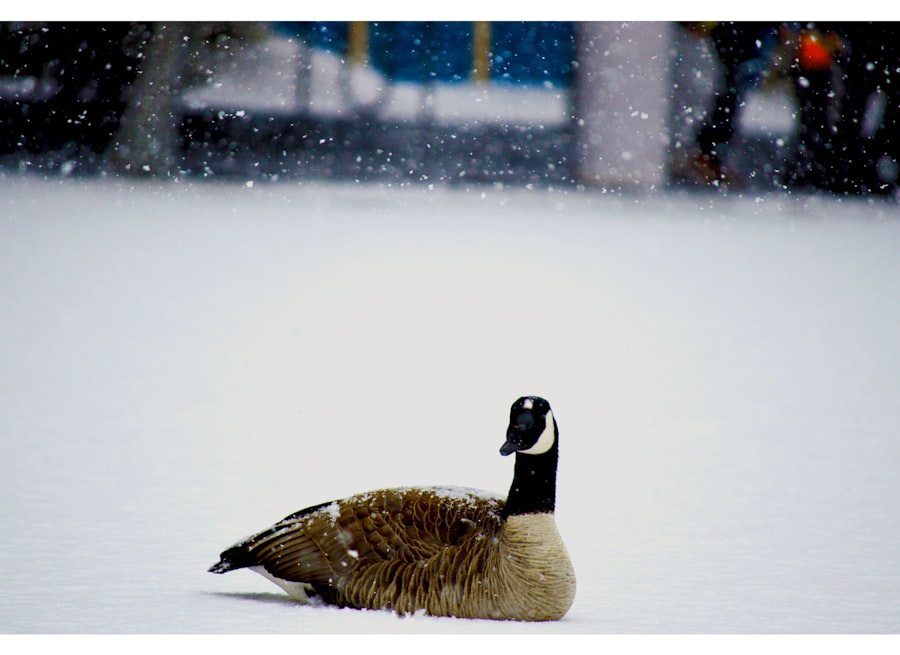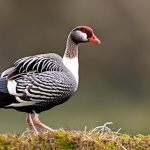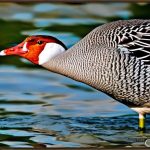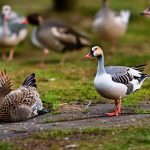Canadian geese are a common sight in many parts of North America, including Canada and the United States. These large waterfowl are known for their distinctive honking calls and V-shaped flight formations. While they may be beautiful to observe, Canadian geese can also be a nuisance, especially when they gather in large numbers and leave behind droppings that can damage property and pose health risks. Understanding the behavior of Canadian geese is crucial in order to effectively deter them and create a goose-free environment.
Key Takeaways
- Canadian geese are social birds that mate for life and are highly protective of their young.
- Effective ways to deter Canadian geese include using noise-making devices, visual deterrents, and physical barriers.
- Creating a goose-proof landscape involves removing food sources, reducing water access, and planting unappealing vegetation.
- Humane methods for goose control include using trained dogs, egg addling, and habitat modification.
- Repellents and deterrents for keeping Canadian geese away include taste aversion sprays, predator decoys, and lasers.
Understanding the behavior of Canadian geese
Migration patterns: Canadian geese are migratory birds, meaning they travel long distances between their breeding grounds in the north and their wintering grounds in the south. They typically migrate in large flocks, following well-established flight paths known as flyways. By understanding these migration patterns, property owners can anticipate when Canadian geese are likely to be present and take appropriate measures to deter them.
Nesting habits: Canadian geese are monogamous and mate for life. They typically build their nests near bodies of water, such as lakes or ponds, where they can find food and protection. The female goose lays an average of 5-7 eggs, which both parents take turns incubating for about a month. Once the goslings hatch, they stay with their parents for several months before becoming independent. Property owners should be aware of nesting sites on their land and take steps to prevent geese from nesting there.
Feeding behavior: Canadian geese are herbivores and primarily feed on grasses, grains, and aquatic plants. They are often attracted to well-maintained lawns and golf courses where they can find ample food. Property owners should be mindful of this feeding behavior and take steps to discourage geese from foraging on their property.
Effective ways to deter Canadian geese
Visual deterrents: Visual deterrents can be effective in deterring Canadian geese. These can include scarecrows, reflective tape, or balloons with predator eyes painted on them. The movement and presence of these visual deterrents can make geese feel threatened and encourage them to find a different location.
Auditory deterrents: Loud noises can also be effective in deterring Canadian geese. This can include using devices that emit distress calls or predator sounds. The sudden loud noises can startle the geese and make them feel unsafe, prompting them to leave the area.
Physical barriers: Physical barriers can be an effective way to keep Canadian geese off your property. This can include installing fences or netting around areas where geese are likely to gather, such as ponds or lawns. These barriers prevent geese from accessing the area and can encourage them to find a different location.
Creating a goose-proof landscape
Choosing the right plants: Canadian geese are attracted to areas with lush grass and vegetation. By choosing plants that are less appealing to geese, property owners can discourage them from foraging on their land. Native plants that are less palatable to geese include yarrow, butterfly weed, and purple coneflower.
Proper lawn maintenance: Regular lawn maintenance can help deter Canadian geese. Keeping the grass short and well-maintained makes it less attractive to geese, as they prefer longer grass for nesting and feeding. Property owners should also promptly remove any fallen leaves or debris from the lawn, as these can provide food sources for geese.
Installing water features: Installing water features such as fountains or water sprayers can help deter Canadian geese. The movement and noise of the water can make geese feel unsafe and encourage them to find a different location. Property owners should ensure that these water features are properly maintained and functioning to be effective.
The importance of humane methods for goose control
Ethical considerations: When deterring Canadian geese, it is important to consider the ethical implications of the methods used. Lethal methods, such as shooting or poisoning, should be avoided as they can cause unnecessary harm to the geese and other wildlife. Humane methods that focus on deterrence and prevention are a more ethical approach.
Alternatives to lethal methods: There are many alternatives to lethal methods for goose control. These can include visual and auditory deterrents, physical barriers, and landscape modifications. By focusing on these non-lethal methods, property owners can effectively manage Canadian geese without causing harm.
Repellents and deterrents for keeping Canadian geese away

Natural repellents: There are several natural repellents that can be used to deter Canadian geese. These can include planting certain types of vegetation that geese find unappealing, such as tall grasses or prickly shrubs. Additionally, spraying a mixture of water and vinegar around areas where geese gather can also discourage them from staying.
Chemical repellents: Chemical repellents can also be effective in deterring Canadian geese. These repellents are typically applied to areas where geese are likely to gather, such as lawns or ponds. The chemicals emit an odor that is unpleasant to geese, causing them to avoid the area.
Ultrasonic devices: Ultrasonic devices emit high-frequency sounds that are inaudible to humans but can be heard by Canadian geese. These devices can be effective in deterring geese from gathering in certain areas. However, it is important to note that the effectiveness of ultrasonic devices may vary depending on the specific situation and the behavior of the geese.
How to prevent Canadian geese from nesting on your property
Removing nesting materials: If Canadian geese have started building a nest on your property, it is important to remove the nesting materials as soon as possible. This can include sticks, grass, and feathers. By removing these materials, you can discourage the geese from continuing to nest on your property.
Installing nest deterrents: There are several nest deterrents that can be installed to prevent Canadian geese from nesting on your property. These can include wire barriers or netting placed around potential nesting sites. These deterrents make it difficult for geese to access the area and discourage them from nesting.
Regular property inspections: Regular property inspections are crucial in preventing Canadian geese from nesting on your property. By regularly checking for signs of nesting activity, such as nests or eggs, you can take immediate action to deter the geese and prevent them from establishing a nest.
Scare tactics for deterring Canadian geese
Motion-activated devices: Motion-activated devices can be effective in deterring Canadian geese. These devices emit sudden movements or noises when geese approach, scaring them away. Examples of motion-activated devices include sprinklers or lights that turn on when geese are detected.
Predator decoys: Predator decoys can also be effective in deterring Canadian geese. These decoys mimic natural predators of geese, such as coyotes or foxes. The presence of these decoys can make geese feel unsafe and encourage them to find a different location.
Scarecrows: Scarecrows have long been used as a scare tactic for deterring birds, including Canadian geese. The presence of a scarecrow can make geese feel threatened and encourage them to find a different location. It is important to regularly move and change the appearance of the scarecrow to maintain its effectiveness.
Professional services for goose management
Hiring a wildlife control company: If you are experiencing persistent issues with Canadian geese on your property, it may be beneficial to hire a wildlife control company. These professionals have experience in managing wildlife populations and can provide effective and humane solutions for deterring geese.
Consulting with a landscape architect: Consulting with a landscape architect can also be helpful in creating a goose-proof environment. These professionals can assess your property and make recommendations for landscape modifications that will discourage geese from gathering and nesting.
Legal considerations when dealing with Canadian geese
Federal and state regulations: It is important to be aware of federal and state regulations regarding the management of Canadian geese. These regulations may vary depending on your location and can include restrictions on hunting or the use of certain deterrent methods. Property owners should familiarize themselves with these regulations to ensure they are in compliance.
Permits and licenses: In some cases, permits or licenses may be required to implement certain goose control methods. This can include obtaining a permit to use chemical repellents or obtaining a hunting license if lethal methods are necessary. Property owners should research the specific requirements in their area and obtain any necessary permits or licenses.
Tips for maintaining a goose-free environment
Regular property inspections: Regular property inspections are crucial in maintaining a goose-free environment. By regularly checking for signs of geese, such as droppings or feathers, you can take immediate action to deter them and prevent them from establishing a presence on your property.
Proper waste disposal: Proper waste disposal is important in deterring Canadian geese. Geese are attracted to areas with abundant food sources, including garbage or food waste. Property owners should ensure that garbage cans are securely closed and that any food waste is properly disposed of to discourage geese from foraging.
Educating neighbors and community members: Educating neighbors and community members about the importance of deterring Canadian geese can help create a more effective and cohesive approach to goose management. By working together, property owners can create a goose-free environment that benefits everyone.
Understanding the behavior of Canadian geese is crucial in effectively deterring them from your property. By implementing a combination of visual and auditory deterrents, physical barriers, and landscape modifications, property owners can create a goose-proof environment. It is important to prioritize humane methods for goose control and be aware of legal considerations when dealing with Canadian geese. By taking action and maintaining a goose-free environment, property owners can enjoy their outdoor spaces without the nuisance and potential health risks associated with Canadian geese.
If you’re looking for effective ways to keep Canadian geese away from your property, you might find this article on Poultry Wizard helpful. They provide valuable insights on how to deter geese and other unwanted birds from your premises. From installing scare devices to creating physical barriers, the article offers practical tips and techniques to protect your space. Check it out here: https://poultrywizard.com/keeping-chickens/farmhouse-chicken-coop/. While you’re there, you can also explore other interesting articles such as “How Many Chickens Do You Need for a Family of 4?” (https://poultrywizard.com/keeping-chickens/how-many-chickens-do-you-need-for-a-family-of-4/) and “The Chicken Coop Country Diner” (https://poultrywizard.com/keeping-chickens/the-chicken-coop-country-diner/). Happy reading and good luck with your goose deterrent efforts!
FAQs
What are Canadian geese?
Canadian geese, also known as Canada geese, are a species of waterfowl native to North America. They are known for their distinctive black heads and necks, white cheeks, and brown bodies.
Why do people want to keep Canadian geese away?
Canadian geese can cause damage to property, create health hazards with their droppings, and become aggressive towards humans during nesting season. Additionally, their large populations can cause ecological imbalances in certain areas.
What are some methods for keeping Canadian geese away?
Some methods for keeping Canadian geese away include using visual deterrents such as scarecrows or reflective tape, using noise deterrents such as loud noises or predator calls, and using physical barriers such as fencing or netting.
Is it legal to harm or kill Canadian geese?
No, it is illegal to harm or kill Canadian geese without a permit from the U.S. Fish and Wildlife Service. Canadian geese are protected under the Migratory Bird Treaty Act.
What should I do if I encounter an aggressive Canadian goose?
If you encounter an aggressive Canadian goose, it is best to slowly back away and avoid making direct eye contact. Do not attempt to feed or touch the goose, as this can further agitate it. If the goose continues to be aggressive, contact local wildlife authorities for assistance.
Meet Walter, the feathered-friend fanatic of Florida! Nestled in the sunshine state, Walter struts through life with his feathered companions, clucking his way to happiness. With a coop that’s fancier than a five-star hotel, he’s the Don Juan of the chicken world. When he’s not teaching his hens to do the cha-cha, you’ll find him in a heated debate with his prized rooster, Sir Clucks-a-Lot. Walter’s poultry passion is no yolk; he’s the sunny-side-up guy you never knew you needed in your flock of friends!







